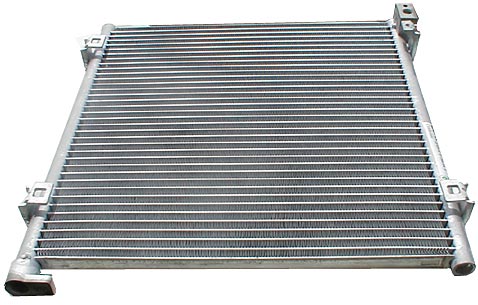Automotive Air Conditioning Condenser
This is the area in which heat dissipation occurs. The condenser, in many cases, will have much the same appearance as the radiator in you car as the two have very similar functions. The condenser is designed to radiate heat. Its location is usually in front of the radiator because it requires the most airflow.Since airflow across the condenser is required, the condenser is located in a area where ramair can occur during road travel. At idle, or during low speed travel, the condenser requires supplemental airflow. On rear wheel drive vehicles, this is usually accomplished by taking advantage of your existing engine's cooling fan. On front wheel drive vehicles, condenser air flow is supplemented with an electric cooling fan(s). Electric fans may operate anytime the system is operational, or controlled by the computer to turn on at specific pressures.
Three thing happen inside the condenser. First, high pressure/high temperature compressed refrigerant gasses are introduced into the top of the condenser. As the gas travels into the condenser, it is cooled, and all superheat is removed. Then the refrigerant condenses into a liquid. That liquid refrigerant is is then subcooled and exits the bottom of the condenser as a subcooled high pressure liquid.
(The picture below represents a typical high efficiency automotive condenser)

Photo courtesy ACSource.Net
If the condenser is not restricted, the refrigerant pressure entering the condenser will be very close to the pressure of the refrigerant leaving the condenser.


